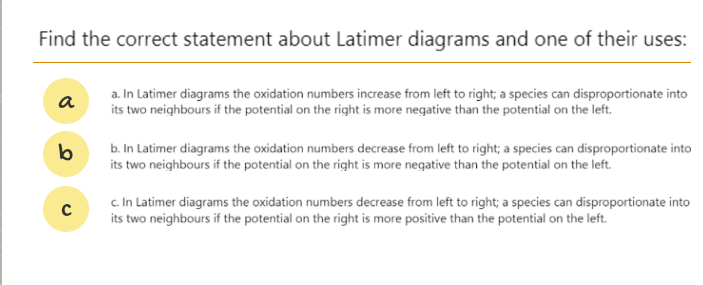Find the correct statement about Latimer diagrams and one of their uses: a. In Latimer diagrams the oxidation numbers increase from left to right; a species can disproportionate into its two neighbours if the potential on the right is more negative than the potential on the left. a b. In Latimer diagrams the oxidation numbers decrease from left to right; a species can disproportionate into its two neighbours if the potential on the right is more negative than the potential on the left. c. In Latimer diagrams the oxidation numbers decrease from left to right; a species can disproportionate into its two neighbours if the potential on the right is more positive than the potential on the left.
Find the correct statement about Latimer diagrams and one of their uses: a. In Latimer diagrams the oxidation numbers increase from left to right; a species can disproportionate into its two neighbours if the potential on the right is more negative than the potential on the left. a b. In Latimer diagrams the oxidation numbers decrease from left to right; a species can disproportionate into its two neighbours if the potential on the right is more negative than the potential on the left. c. In Latimer diagrams the oxidation numbers decrease from left to right; a species can disproportionate into its two neighbours if the potential on the right is more positive than the potential on the left.
General Chemistry - Standalone book (MindTap Course List)
11th Edition
ISBN:9781305580343
Author:Steven D. Gammon, Ebbing, Darrell Ebbing, Steven D., Darrell; Gammon, Darrell Ebbing; Steven D. Gammon, Darrell D.; Gammon, Ebbing; Steven D. Gammon; Darrell
Publisher:Steven D. Gammon, Ebbing, Darrell Ebbing, Steven D., Darrell; Gammon, Darrell Ebbing; Steven D. Gammon, Darrell D.; Gammon, Ebbing; Steven D. Gammon; Darrell
Chapter21: Chemistry Of The Main-group Elements
Section: Chapter Questions
Problem 21.182QP
Related questions
Question

Transcribed Image Text:Find the correct statement about Latimer diagrams and one of their uses:
a. In Latimer diagrams the oxidation numbers increase from left to right; a species can disproportionate into
its two neighbours if the potential on the right is more negative than the potential on the left.
a
b. In Latimer diagrams the oxidation numbers decrease from left to right; a species can disproportionate into
its two neighbours if the potential on the right is more negative than the potential on the left.
c. In Latimer diagrams the oxidation numbers decrease from left to right; a species can disproportionate into
its two neighbours if the potential on the right is more positive than the potential on the left.
Expert Solution
This question has been solved!
Explore an expertly crafted, step-by-step solution for a thorough understanding of key concepts.
This is a popular solution!
Trending now
This is a popular solution!
Step by step
Solved in 4 steps with 1 images

Knowledge Booster
Learn more about
Need a deep-dive on the concept behind this application? Look no further. Learn more about this topic, chemistry and related others by exploring similar questions and additional content below.Recommended textbooks for you

General Chemistry - Standalone book (MindTap Cour…
Chemistry
ISBN:
9781305580343
Author:
Steven D. Gammon, Ebbing, Darrell Ebbing, Steven D., Darrell; Gammon, Darrell Ebbing; Steven D. Gammon, Darrell D.; Gammon, Ebbing; Steven D. Gammon; Darrell
Publisher:
Cengage Learning


Chemistry: An Atoms First Approach
Chemistry
ISBN:
9781305079243
Author:
Steven S. Zumdahl, Susan A. Zumdahl
Publisher:
Cengage Learning

General Chemistry - Standalone book (MindTap Cour…
Chemistry
ISBN:
9781305580343
Author:
Steven D. Gammon, Ebbing, Darrell Ebbing, Steven D., Darrell; Gammon, Darrell Ebbing; Steven D. Gammon, Darrell D.; Gammon, Ebbing; Steven D. Gammon; Darrell
Publisher:
Cengage Learning


Chemistry: An Atoms First Approach
Chemistry
ISBN:
9781305079243
Author:
Steven S. Zumdahl, Susan A. Zumdahl
Publisher:
Cengage Learning

Chemistry
Chemistry
ISBN:
9781305957404
Author:
Steven S. Zumdahl, Susan A. Zumdahl, Donald J. DeCoste
Publisher:
Cengage Learning

Principles of Modern Chemistry
Chemistry
ISBN:
9781305079113
Author:
David W. Oxtoby, H. Pat Gillis, Laurie J. Butler
Publisher:
Cengage Learning

Chemistry: The Molecular Science
Chemistry
ISBN:
9781285199047
Author:
John W. Moore, Conrad L. Stanitski
Publisher:
Cengage Learning